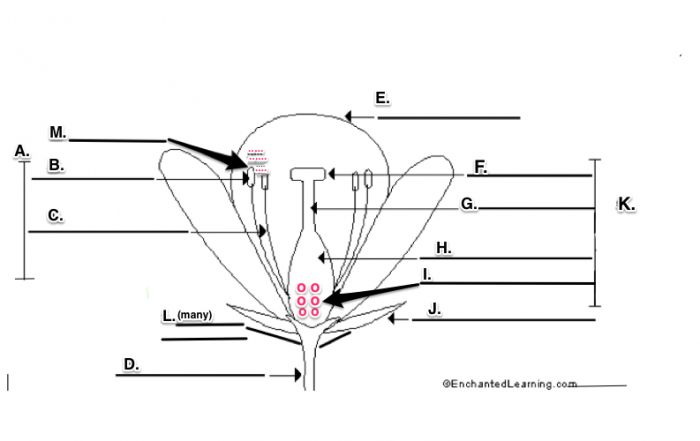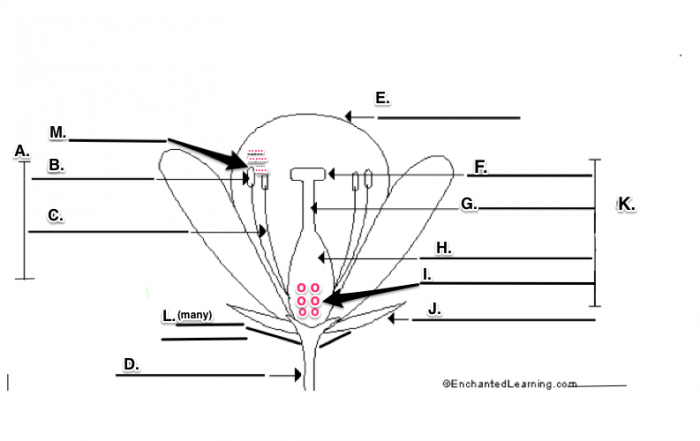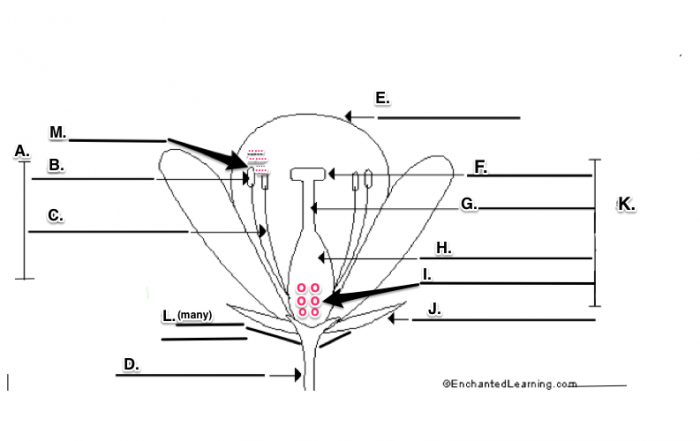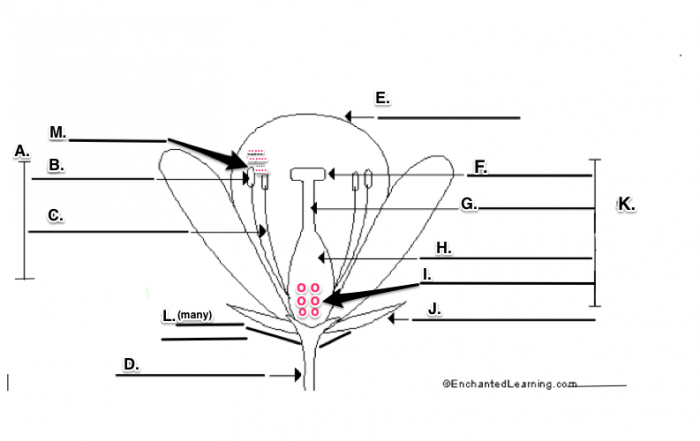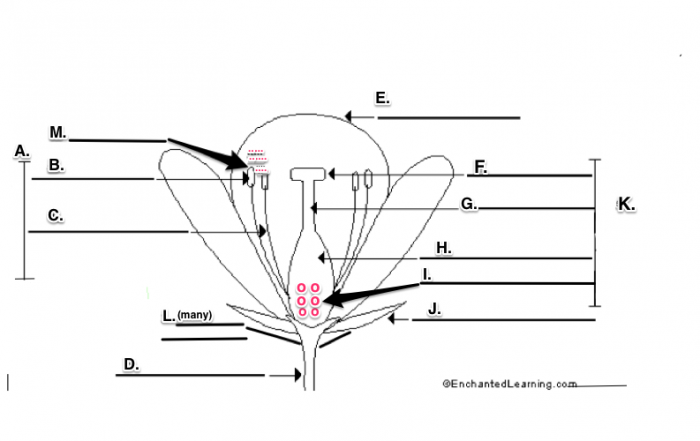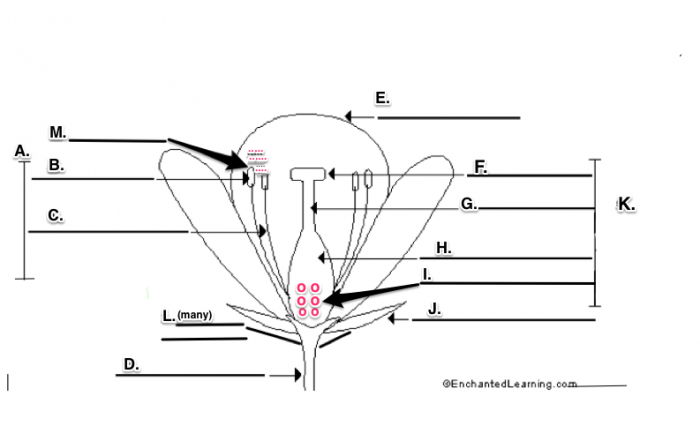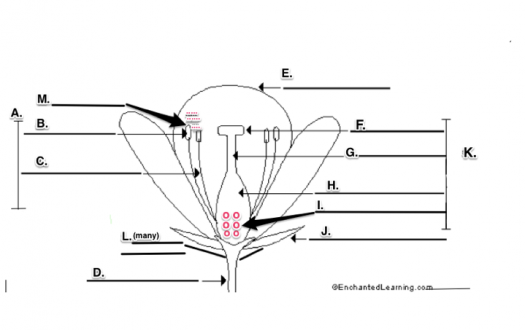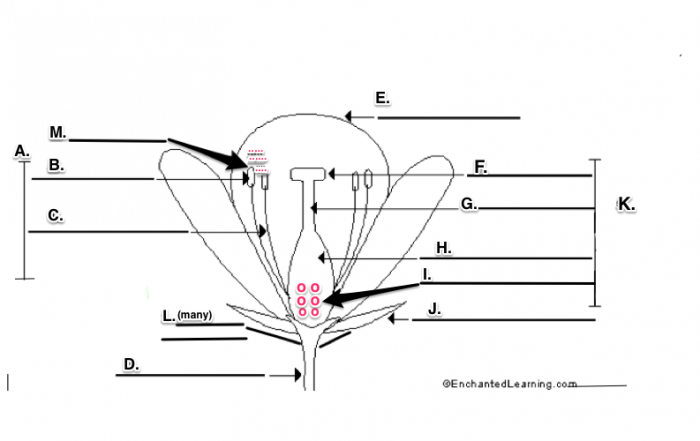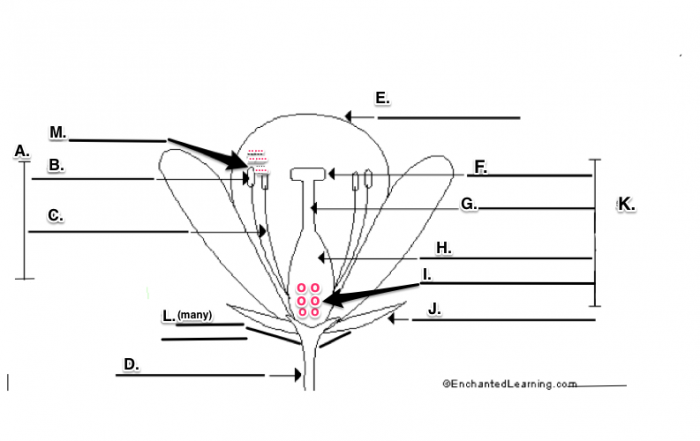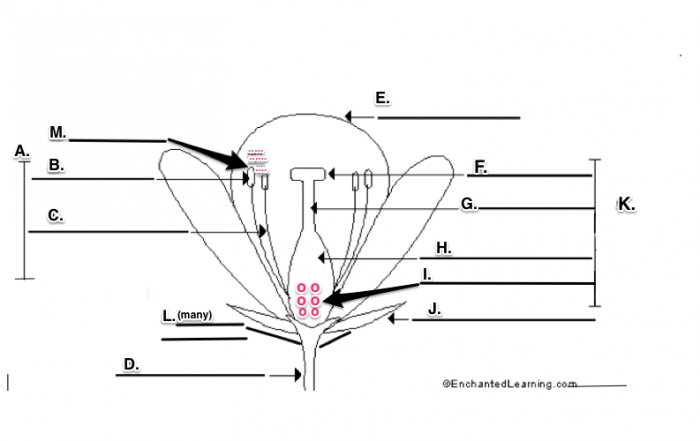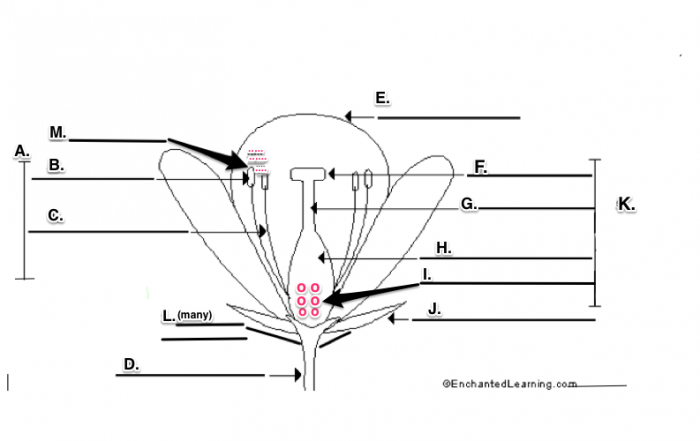Anatomy And Physiology Of A Flowering Plant
-
The stem of the flowering plant is called the:
-
Peduncle.
-
Petal.
-
Pistil.
-
Calyx.
-
This quiz focuses on the anatomy and physiology of flowering plants, testing knowledge of various plant parts through identification exercises.
.webp)
Quiz Preview
- 2.
Identify the Flowering Plant Parts - FNot all words will be used.
-
Calyx
-
Angiosperm
-
Dicot
-
Filament
-
Ovule
-
Pistil
-
Stamen
-
Anther
-
Egg
-
Monocot
-
Petal
-
Pollen
-
Stigma
-
Brassica
-
Cotyledon
-
Hypocotyl
-
Ovary
-
Peduncle
-
Sepal
-
Style
Correct Answer
A. StigmaExplanation
The stigma is the part of the flower that receives pollen during pollination. It is located at the top of the pistil, the female reproductive organ of a flower. The stigma is sticky or feathery in order to catch and hold onto pollen grains. Once pollen lands on the stigma, it can then travel down the style to reach the ovary and fertilize the ovules, leading to the development of seeds.Rate this question:
-
- 3.
The male reproductive parts of the flowering plant are called:
-
Stamen.
-
Stigma.
-
Sepal.
-
Pistil.
Correct Answer
A. Stamen.Explanation
The male reproductive parts of a flowering plant are called stamens. The stamen consists of two main parts: the filament and the anther. The filament is a long, slender structure that holds up the anther, which is the part that produces pollen. The stamen plays a crucial role in the process of pollination, as it releases pollen grains that can fertilize the female reproductive parts of the plant. Therefore, stamen is the correct answer for this question.Rate this question:
-
- 4.
The brightly-colored, structures that surround and hold a flower are called:
-
Petal
-
Anther
-
Style
-
Brassica
Correct Answer
A. PetalExplanation
The brightly-colored, structures that surround and hold a flower are called petals. Petals are often the most visually striking part of a flower and serve several functions such as attracting pollinators and protecting the reproductive organs of the flower. They come in a variety of colors, shapes, and sizes, adding to the overall beauty and diversity of flowers.Rate this question:
-
- 5.
The tip of a flower's male reproductive organ, contains pollen are called:
-
Stamen
-
Pistil
-
Anther
-
Stigmal
Correct Answer
A. AntherExplanation
The tip of a flower's male reproductive organ, which contains pollen, is called the anther. The anther is responsible for producing and releasing pollen grains, which are necessary for the process of pollination and fertilization in plants. It is located at the top of the stamen, which is the male reproductive part of the flower. The anther plays a crucial role in the reproductive cycle of flowering plants by facilitating the transfer of pollen to the female reproductive organs of other flowers.Rate this question:
-
- 6.
Identify the Flowering Plant Parts - ENot all words will be used.
-
Calyx
-
Angiosperm
-
Dicot
-
Filament
-
Ovule
-
Pistil
-
Stamen
-
Anther
-
Egg
-
Monocot
-
Petal
-
Pollen
-
Stigma
-
Brassica
-
Cotyledon
-
Hypocotyl
-
Ovary
-
Peduncle
-
Sepal
-
Style
Correct Answer
A. PetalExplanation
The correct answer is "Petal". Petals are the brightly colored part of a flower that are often seen as the most visually attractive. They are located inside the calyx, which is the outermost part of the flower that protects the developing bud. Petals are important for attracting pollinators, such as bees and butterflies, to the flower for the purpose of pollination.Rate this question:
-
- 7.
Identify the Flowering Plant Parts - MNot all words will be used.
-
Calyx
-
Angiosperm
-
Dicot
-
Filament
-
Ovule
-
Pistil
-
Stamen
-
Anther
-
Egg
-
Monocot
-
Petal
-
Pollen
-
Stigma
-
Brassica
-
Cotyledon
-
Hypocotyl
-
Ovary
-
Peduncle
-
Sepal
-
Style
Correct Answer
A. PollenExplanation
Pollen is the correct answer because it is a crucial part of the reproductive system in flowering plants. It is a fine powdery substance produced by the anthers of the stamen. Pollen contains the male gametes, or sperm cells, which are necessary for fertilization. It is transferred from the anther to the stigma, where it can then travel down the style to reach the ovary and fertilize the ovule. Pollen plays a vital role in plant reproduction and is essential for the development of seeds and fruits.Rate this question:
-
- 8.
Identify the Flowering Plant Parts - CNot all words will be used.
-
Calyx
-
Angiosperm
-
Dicot
-
Filament
-
Ovule
-
Pistil
-
Stamen
-
Anther
-
Egg
-
Monocot
-
Petal
-
Pollen
-
Stigma
-
Brassica
-
Cotyledon
-
Hypocotyl
-
Ovary
-
Peduncle
-
Sepal
-
Style
Correct Answer
A. FilamentExplanation
The filament is a part of a flowering plant. It is a long, slender structure that supports the anther, which is the part of the flower that produces pollen. The filament is usually located in the center of the flower and is responsible for holding the anther in place, allowing it to release pollen. It plays a crucial role in the reproductive process of flowering plants by ensuring the transfer of pollen to the stigma, where fertilization can occur.Rate this question:
-
- 9.
Identify the Flowering Plant Parts - DNot all words will be used.
-
Calyx
-
Angiosperm
-
Dicot
-
Filament
-
Ovule
-
Pistil
-
Stamen
-
Anther
-
Egg
-
Monocot
-
Petal
-
Pollen
-
Stigma
-
Brassica
-
Cotyledon
-
Hypocotyl
-
Ovary
-
Peduncle
-
Sepal
-
Style
Correct Answer
A. PeduncleExplanation
The peduncle is the correct answer because it is a part of a flowering plant. The peduncle is the stalk that supports the flower and connects it to the main stem or branch of the plant. It is responsible for holding the flower upright and providing it with nutrients and water.Rate this question:
-
- 10.
The name of the tube above the female reproductive organ.
-
Style.
-
Stigma.
-
Sepal.
-
Carpel.
Correct Answer
A. Style.Explanation
The style is the name of the tube above the female reproductive organ. In flowers, the style is a slender, elongated structure that connects the stigma (the receptive surface for pollen) to the ovary. It allows for the transportation of pollen grains from the stigma to the ovary, where fertilization takes place. The style plays a crucial role in the reproductive process of flowering plants.Rate this question:
-
- 11.
Identify the Flowering Plant Parts - BNot all words will be used.
-
Angiosperm
-
Calyx
-
Dicot
-
Filament
-
Ovule
-
Pistil
-
Stamen
-
Anther
-
Egg
-
Monocot
-
Petal
-
Pollen
-
Stigma
-
Brassica
-
Cotyledon
-
Hypocotyl
-
Ovary
-
Peduncle
-
Sepal
-
Style
Correct Answer
A. AntherExplanation
Anther is the correct answer because it is a part of the stamen, which is the male reproductive organ of a flowering plant. The anther produces pollen, which contains the plant's male gametes.Rate this question:
-
- 12.
Identify the Flowering Plant Parts - GNot all words will be used.
-
Calyx
-
Angiosperm
-
Dicot
-
Filament
-
Ovule
-
Pistil
-
Stamen
-
Anther
-
Egg
-
Monocot
-
Petal
-
Pollen
-
Stigma
-
Brassica
-
Cotyledon
-
Hypocotyl
-
Ovary
-
Peduncle
-
Sepal
-
Style
Correct Answer
A. StyleExplanation
The style is a part of a flowering plant. It is a long, slender stalk that connects the stigma to the ovary. The style plays a crucial role in reproduction as it allows the pollen to travel from the stigma to the ovary, where fertilization takes place.Rate this question:
-
- 13.
Identify the Flowering Plant Parts - HNot all words will be used.
-
Calyx
-
Angiosperm
-
Dicot
-
Filament
-
Ovule
-
Pistil
-
Stamen
-
Anther
-
Egg
-
Monocot
-
Petal
-
Pollen
-
Stigma
-
Brassica
-
Cotyledon
-
Hypocotyl
-
Ovary
-
Peduncle
-
Sepal
-
Style
Correct Answer
A. OvaryExplanation
The correct answer is "Ovary". The ovary is a part of the flowering plant that contains the ovules, which eventually develop into seeds after fertilization. It is located at the base of the pistil, which is the female reproductive organ of the flower. The ovary plays a crucial role in the reproduction of flowering plants by protecting and nourishing the developing seeds.Rate this question:
-
- 14.
Identify the Flowering Plant Parts - ANot all words will be used.
-
Angiosperm
-
Calyx
-
Dicot
-
Filament
-
Ovule
-
Pistil
-
Stamen
-
Anther
-
Egg
-
Monocot
-
Petal
-
Pollen
-
Stigma
-
Brassica
-
Cotyledon
-
Hypocotyl
-
Ovary
-
Peduncle
-
Sepal
-
Style
Correct Answer
A. StamenExplanation
The stamen is the male reproductive organ of a flowering plant, consisting of the filament and anther. The filament is a long, slender stalk that supports the anther, which produces pollen. The stamen plays a crucial role in pollination, as the pollen is transferred from the anther to the stigma of the pistil, leading to fertilization and the production of seeds.Rate this question:
-
- 15.
Identify the Flowering Plant Parts - KNot all words will be used.
-
Calyx
-
Angiosperm
-
Dicot
-
Filament
-
Ovule
-
Pistil
-
Stamen
-
Anther
-
Egg
-
Monocot
-
Petal
-
Pollen
-
Stigma
-
Brassica
-
Cotyledon
-
Hypocotyl
-
Ovary
-
Peduncle
-
Sepal
-
Style
Correct Answer
A. PistilExplanation
The pistil is the female reproductive organ of a flowering plant. It is composed of three main parts: the stigma, style, and ovary. The stigma is the sticky structure at the top of the pistil that receives pollen. The style is a slender tube that connects the stigma to the ovary. The ovary contains the ovules, which are the structures that develop into seeds after fertilization. The pistil plays a crucial role in the reproduction of flowering plants by receiving pollen and facilitating the fertilization process.Rate this question:
-
- 16.
Identify the Flowering Plant Parts - INot all words will be used.
-
Calyx
-
Angiosperm
-
Dicot
-
Filament
-
Ovule
-
Pistil
-
Stamen
-
Anther
-
Egg
-
Monocot
-
Petal
-
Pollen
-
Stigma
-
Brassica
-
Cotyledon
-
Hypocotyl
-
Ovary
-
Peduncle
-
Sepal
-
Style
Correct Answer
A. OvuleExplanation
The ovule is a part of a flowering plant that contains the female reproductive cells, or eggs. It is located within the ovary, which is the part of the plant that eventually develops into a fruit. The ovule plays a crucial role in the process of fertilization, as it is where the pollen lands and the sperm cells travel to fertilize the eggs. Once fertilized, the ovule develops into a seed.Rate this question:
-
- 17.
The part of the flower that holds up the pollen producing part are called:
-
Peduncle
-
Style
-
Carpel pistil
-
Filament
Correct Answer
A. FilamentExplanation
The filament is the correct answer because it is the part of the flower that holds up the pollen producing part, which is the anther. The filament is a long, slender structure that connects the anther to the rest of the flower. It provides support for the anther and allows it to be positioned in a way that facilitates pollination.Rate this question:
-
- 18.
The female reproductive cell is called a/an:
-
Carpel/pistil
-
Ovule/egg
-
Calyx
-
Ovary
Correct Answer
A. Ovule/eggExplanation
The female reproductive cell in plants is called an ovule, which is equivalent to an egg in animals. The ovule contains the female gamete and is located within the ovary of a flower. It is the structure that is fertilized by the male gamete, or pollen, leading to the development of a seed. The other options listed, such as carpel/pistil, calyx, and ovary, are all parts of the flower's reproductive system but do not specifically refer to the female reproductive cell.Rate this question:
-
- 19.
Identify the Flowering Plant Parts - LNot all words will be used.
-
Calyx
-
Angiosperm
-
Dicot
-
Filament
-
Ovule
-
Pistil
-
Stamen
-
Anther
-
Egg
-
Monocot
-
Petal
-
Pollen
-
Stigma
-
Brassica
-
Cotyledon
-
Hypocotyl
-
Ovary
-
Peduncle
-
Sepal
-
Style
Correct Answer
A. CalyxExplanation
The calyx is the outermost whorl of a flower, consisting of sepals. Sepals are typically green and protect the developing flower bud. They are usually leaf-like structures that enclose and protect the inner parts of the flower during development. The calyx plays a crucial role in protecting the flower and its reproductive structures, as well as attracting pollinators.Rate this question:
-
- 20.
Identify the Flowering Plant Parts - JNot all words will be used.
-
Ovule
-
Pistil
-
Stamen
-
Anther
-
Egg
-
Monocot
-
Petal
-
Pollen
-
Stigma
-
Brassica
-
Cotyledon
-
Hypocotyl
-
Ovary
-
Peduncle
-
Sepal
-
Style
-
Calyx
-
Angiosperm
-
Dicot
-
Filament
Correct Answer
A. SepalExplanation
The sepal is a part of the flowering plant that protects the developing flower bud. It is usually green and leaf-like in appearance. The sepal is located at the base of the flower and forms the outermost whorl of floral organs, together with the petals. Its main function is to provide support and protection to the developing flower bud, as well as to attract pollinators. In some cases, the sepals may also play a role in photosynthesis.Rate this question:
-
Quiz Review Timeline (Updated): May 14, 2024 +
Our quizzes are rigorously reviewed, monitored and continuously updated by our expert board to maintain accuracy, relevance, and timeliness.
-
Current Version
-
May 14, 2024Quiz Edited by
ProProfs Editorial Team -
May 01, 2015Quiz Created by
Rhaveno
Anatomy Of Flowering Plants! Quiz
Flowering plants are beautiful and come in all different colors, shapes, and sizes. Examples of flowering plants include the black-eyed Susan, geranium, English lavender, daylily,...
Questions:
22 |
Attempts:
634 |
Last updated:
Mar 22, 2023
|
Parts And Functions Of The Plant Quiz
Embark on a botanical journey with the "Parts and Functions of the Plant" Quiz, exploring the intricate world of flora. Test your knowledge of plant anatomy as you...
Questions:
8 |
Attempts:
1060 |
Last updated:
Dec 04, 2023
|
Trees Terminologies Trivia
This quiz assesses your knowledge of our plant structure and growth lesson.
Questions:
15 |
Attempts:
146 |
Last updated:
Mar 19, 2022
|
Homework Check Flower Parts
The 'Homework Check flower parts' quiz assesses knowledge on the structure of flower parts including stigma, style, ovary, ovule, and their collective term, pistil or carpel, plus...
Questions:
15 |
Attempts:
449 |
Last updated:
Mar 18, 2023
|
The Organ System Of Plants
Explore the intricate organ system of plants with our quiz! Dive into the root and tissue systems, understand nodes and internodes, and grasp the vast number of root hairs. This...
Questions:
5 |
Attempts:
476 |
Last updated:
Mar 22, 2023
|
Flowers, Fruits, And Seeds
Explore the fundamentals of plant life in the 'Flowers, Fruits, and Seeds' quiz. Understand the differences between annuals and perennials, learn about the structure of flowers...
Questions:
57 |
Attempts:
1777 |
Last updated:
Mar 22, 2023
|
 Back to top
Back to top



